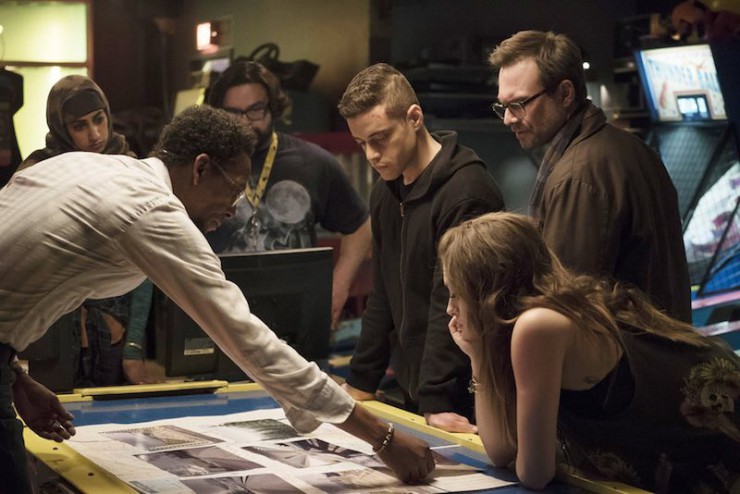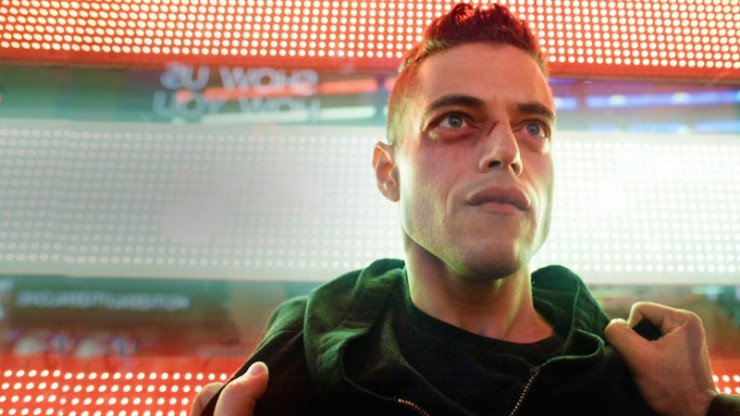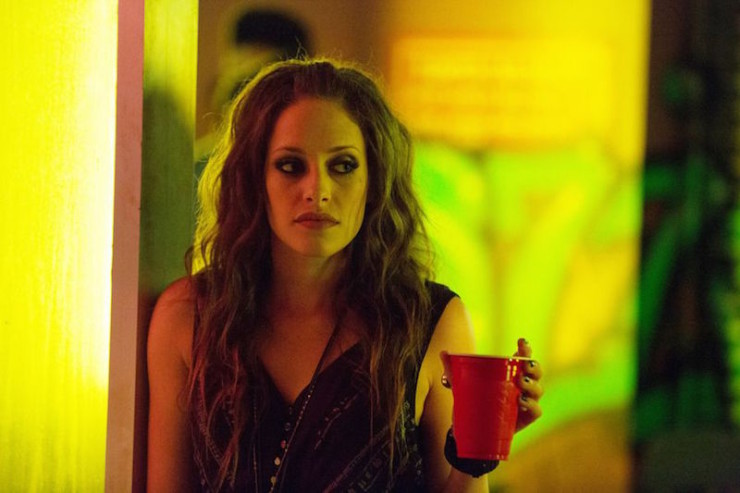Cyberpunk may have been one of the 1980s’ most quintessential subgenre-movement-phenomena, and it also may have been one of the quickest to descend into self-parody. It was easy to get hung up on the aesthetics—chrome, casual violence, neon reflected in dirty puddles, mirrored sunglasses, neo-Orientalist imagery driven by fears of a economically dominant Japan—while only superficially engaging with the deeper themes of the technology-driven, corporation-dominated near-futures portrayed therein.
Then the Internet age proceeded to co-opt the vocabulary of cyberpunk, much as the world of espionage absorbed the lingo of John le Carré’s fictional spies. Brief resurgences via The Matrix and Snow Crash (which is more satirical than some people realize) notwithstanding, cyberpunk now seems like a quaint retro-future at best, and entirely moribund at worst.
At least it did until Sam Esmail’s television series Mr. Robot came along—and on the USA Network, of all places. In a recent Reddit AMA, Esmail stated that he “wanted to bring cyberpunk to TV,” and he has actually done it—and in the process, reinvented cyberpunk and made it valid again for the twenty-first century.
Now before I go any further, you need to know that I can’t talk about this show in any kind of depth without getting spoilers all over everything. So if you haven’t seen Mr. Robot yet, fix that. Bookmark this article and come back after you’ve binged all ten brilliantly queasy episodes and been left dazedly wondering what in the actual hell is going to happen next season. Very few other shows on TV right now have Mr. Robot‘s caliber of writing, direction, and acting, or such an intense commitment to an aesthetic vision. And very few TV shows have actually made the viewers question their own perceptions, to say nothing of the perceptions of its thoroughly unreliable, often creepy, and unexpectedly sympathetic narrator and protagonist, IT security engineer and vigilante hacker Elliot Alderson (Rami Malek), as he leads a motley band of hackers called fsociety in a strike against the biggest megacorporation in the world.
However, if you’ve watched it, or have a devil-may-care attitude toward spoilers, read on.
So how do you make a cyberpunk television show these days? Mr. Robot does indulge in the occasional retro touch—there’s a visual callback in the ’80s-vintage typeface of the Mr. Robot title card. The soundtrack (which probably deserves its own analysis) deploys 1980s alternative music to great effect: The Cure’s “Pictures of You” plays as Elliot packs away his files on his girlfriend Shayla (Frankie Shaw) in the wake of her murder, and the Jim Carroll Band’s “People Who Died” accompanies a darkly comic scene of data destruction in a crematorium for dogs.
Meanwhile, the show plays liberally with classic cyberpunk tropes: Elliot the alienated hacker-antihero; Whiterose (BD Wong, running away with that episode tucked in his pocket), an enigmatic Asian transgender hacker who operates out of a Faraday cage in the basement of a computer repair shop; and the global conglomerate E Corp, referred to universally—even by its employees, in one of those devices that makes the world’s reality just a little more unstable for the audience—as Evil Corp. And the name of Elliot’s slippery adversary/ally Tyrell Wellick (Martin Wallström) seems like a cheeky nod toward Blade Runner.
Apart from a stated and obvious debt to the David Fincher film adaptation of Fight Club (nicely lampshaded when Maxence Cyrin’s piano cover of the Pixies’ “Where Is My Mind” plays over the closing scene of the penultimate episode), Esmail is somewhat cagey about the fictional influences at work on Mr. Robot; in the Reddit AMA, he says his main influences are “real hackers and programmers.” But it’s hard not to notice a few powerful resonances with William Gibson’s Neuromancer—and if they’re accidental, it only underlines the extent to which Neuromancer‘s literary DNA is embedded in the culture. Elliot’s drug habit and hacker life make him a spiritual brother to Case, and both he and Case are guided by the shades of dead mentors. For Case, it’s a software construct of his teacher McCoy “Dixie Flatline” Pauley. For Elliot, it’s the titular Mr. Robot (Christian Slater), an imaginary construct of his own father—but a construct fragmented from his own personality, and from which Elliot is so alienated that he doesn’t even recognize him. Even the tragic fate of Elliot’s girlfriend Shayla echoes that of Case’s lover Linda Lee.
But none of this would sustain interest if the pleasures of Mr. Robot were purely retro. The show works because Esmail and his writers apply the tropes of cyberpunk in a distinctly contemporary way, to a setting that is recognizable as our own world—complete with a reference to the Ashley Madison hack and data dump in the season finale. As William Gibson did in his Blue Ant trilogy, Esmail seems to accept that the world we live in is at least as weird as any SF setting conceived of in the 1980s, and just rolls with it.
Traditional cyberpunk locates the hacker as a figure outside of society—but as William Gibson has pointed out, technology that was formerly “punk” or fringe is now mainstream. Nowadays, “outside of society” is “off the grid,” where there’s no connectivity. The contemporary cyberpunk of Mr. Robot is concerned with the place of an individual within a capitalist system. Elliot and the members of fsociety can exist only briefly in the non-wired outlands; to execute their opposition to the the neoliberal capitalism of the West, they have to enter into and participate within it.
What’s more, there’s a strong suggestion that destruction of or escape from the system may be impossible. While fsociety tries to destroy Evil Corp by attacking its wired infrastructure, Elliot’s childhood friend Angela (Portia Doubleday) attempts to break the conglomerate from without via litigation. The fsociety hack leads to global chaos, a horrifying public suicide, and the ruination of Elliot’s kindhearted boss Gideon (Michael Gill), and yet Evil Corp’s CEO is strangely unperturbed by the whole affair, confiding to Whiterose in the finale’s post-credits scene that he knows who’s behind the hack and has the matter well in hand. Meanwhile Angela, naively thinking that by accepting an Evil Corp job offer she can try to change the machine, instead discovers that it’s all too easy to simply become a part of it.
Perhaps madness is a natural reaction to such a paradox; perhaps Elliot’s major case of dissociative personality disorder is a product of his own neurology colliding with the strain of existing in a world that you want to resist, but can’t. Tyrell Wellick and his delightfully ruthless wife Joanna (Stephanie Corneliussen, dazzling) are both deeply unhinged in their own sociopathies. Elliot’s sister Darlene (Carly Chaikin)—whose identity was the twist that just about no one saw coming—almost seems to have it together, but much of her own story still remains a mystery. There’s an undercurrent of desperation in her commitment to fsociety; in the finale, she seems to be trying to persuade herself of the rightness and success of the hack as much as she’s trying to sustain the morale of her comrades. By the end of season 1, everything seems to be on the verge of flying apart for all the characters. In a motif that occurs more than once in the series, we’re asked: Now that you’ve broken the system, what do you do with it?
This is how cyberpunk becomes relevant again. All science fiction is about the era in which it’s written in some way, but nowadays the tropes of cyberpunk are less useful as a tool for futurism than as a means by which present, contemporary dread of dystopia and collapse can be directly written about, heightened, and examined. Sam Esmail and his excellent crew of writers, directors, and performers have gotten it right with Mr. Robot, and I can’t wait to see where it goes next.
Images courtesy of NBC Universal
Karin Kross lives and writes in Austin, TX. She may be found elsewhere on Tumblr and Twitter.















